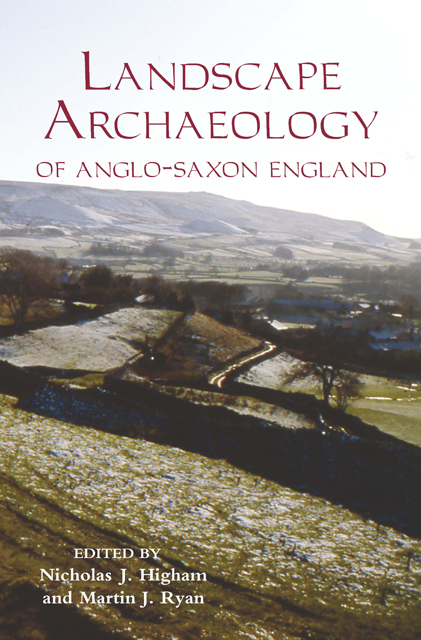Book contents
- Frontmatter
- Contents
- List of Illustrations
- Contributors
- Acknowledgements
- Abbreviations
- 1 The Landscape Archaeology of Anglo-Saxon England: An Introduction
- 2 Barriers to Knowledge: Coppicing and Landscape Usage in the Anglo-Saxon Economy
- 3 Landscape Change during the ‘Long Eighth Century’ in Southern England
- 4 Population Ecology and Multiple Estate Formation: The Evidence from Eastern Kent
- 5 Exploring Black Holes: Recent Investigations in Currently Occupied Rural Settlements in Eastern England
- 6 Medieval Field Systems and Settlement Nucleation: Common or Separate Origins?
- 7 The Environmental Contexts of Anglo-Saxon Settlement
- 8 Calendar Illustration in Anglo-Saxon England: Realities and Fictions of the Anglo-Saxon Landscape
- 9 The Anglo-Saxon Plough: A Detail of the Wheels
- 10 ‘In the Sweat of thy Brow Shalt thou eat Bread’: Cereals and Cereal Production in the Anglo-Saxon Landscape
- 11 The Early Christian Landscape of East Anglia
- 12 The Landscape and Economy of the Anglo-Saxon Coast: New Archaeological Evidence
- Index
9 - The Anglo-Saxon Plough: A Detail of the Wheels
Published online by Cambridge University Press: 16 February 2023
- Frontmatter
- Contents
- List of Illustrations
- Contributors
- Acknowledgements
- Abbreviations
- 1 The Landscape Archaeology of Anglo-Saxon England: An Introduction
- 2 Barriers to Knowledge: Coppicing and Landscape Usage in the Anglo-Saxon Economy
- 3 Landscape Change during the ‘Long Eighth Century’ in Southern England
- 4 Population Ecology and Multiple Estate Formation: The Evidence from Eastern Kent
- 5 Exploring Black Holes: Recent Investigations in Currently Occupied Rural Settlements in Eastern England
- 6 Medieval Field Systems and Settlement Nucleation: Common or Separate Origins?
- 7 The Environmental Contexts of Anglo-Saxon Settlement
- 8 Calendar Illustration in Anglo-Saxon England: Realities and Fictions of the Anglo-Saxon Landscape
- 9 The Anglo-Saxon Plough: A Detail of the Wheels
- 10 ‘In the Sweat of thy Brow Shalt thou eat Bread’: Cereals and Cereal Production in the Anglo-Saxon Landscape
- 11 The Early Christian Landscape of East Anglia
- 12 The Landscape and Economy of the Anglo-Saxon Coast: New Archaeological Evidence
- Index
Summary
A small but important group of illustrations of the plough and other agricultural equipment survives from late Anglo-Saxon and early Anglo- Norman England. This has been discounted as contemporary evidence as to what was actually happening in the English countryside by several scholars, on the grounds that manuscript illustration rested heavily on the repetition of preexisting manuscript models dating ultimately back to the Ancient World. This somewhat nihilistic view has, however, been cautiously challenged by Martin Carver, and more forthrightly by the author in 1998, making the case that the Gerefa, an eleventh-century guide to estate management in Old English, demonstrates the relevance to the English countryside of the Labours of the Months as set out in the calendar illuminations. As regards the evidence for the plough, I have already published a discussion and overall assessment. What follows, therefore, should be read very much as an addendum to the papers published in 1998 and 2000 regarding just one problem thrown up by the illustrations, namely the size and nature of the wheel(s) depicted in representations of the plough, which has emerged in the course of a current project by Derek Seddon and myself to build a scale-model of an Anglo-Saxon plough. Such a threedimensional effort raises all kinds of questions of reality. Words can come easily and lead to facile explanations, but models raise hard problems, as we found when we built a model of an Anglo-Saxon wagon, with which we were greatly assisted by the late Bob Beech of the Guild of Model Wheelwrights. Much rests on the series of late Anglo-Saxon illustrations and also the depiction of a plough in the Bayeux Tapestry. The view chosen by the artist commonly illustrates only one wheel of the pair with the second hidden behind the first; this is also true of contemporary illustrations of the wheels of Anglo-Saxon wagons.
Only one of these illustrations is from a viewpoint where both wheels are shown and this is the plough on the Bayeux Tapestry. There is a series of linked vignettes in the lower border which carries a sequence of cultivation, from ploughing the soil through seeding and harrowing to scaring birds off the growing crop (Fig. 9.1a).
- Type
- Chapter
- Information
- The Landscape Archaeology of Anglo-Saxon England , pp. 169 - 174Publisher: Boydell & BrewerPrint publication year: 2010
- 1
- Cited by

